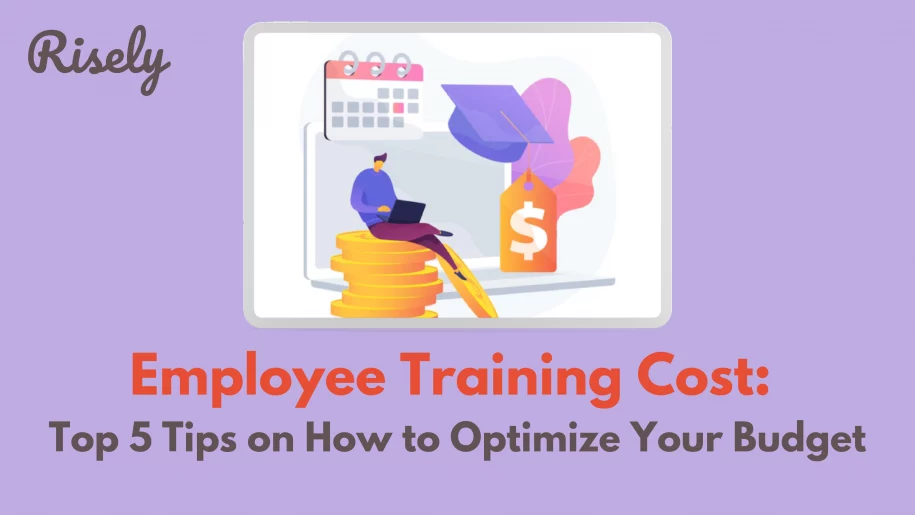Employee Training Cost: Top 5 Tips on How to Optimize Your Budget
As a business owner, you understand the importance of employee training. But have you ever stopped to consider the cost? Employee training programs can quickly eat into your budget if not properly managed. In this blog post, we will dive deep into the employee training costs and uncover hidden expenses you may not have considered. We will also provide valuable insights on calculating the training cost per employee.And most importantly, we will share our top 5 tips for optimizing your budget and minimizing employee training costs without compromising quality. So, if you’re ready to make your training program more efficient and cost-effective, keep reading!What is the Employee Training Cost?
Employee training costs include various components such as trainers’ fees, travel expenses, training materials, and potential loss of productivity during training. It also depends on factors like the duration and complexity of the training program. It encompasses the time and effort put in by trainers and employees, as well as any necessary materials or technology. Additional expenses like travel, accommodation, and meals for off-site training can also impact the overall cost. The specific type of program, duration, and number of participants influence the total cost. All of these are important components while you are calculating the ROI of L&D.Hidden costs of employee training
Hidden employee training cost refer to the indirect or unexpected expenses that can arise during the training process. Here are some typical hidden employee training costs to consider:- Backfill Costs: When employees participate in training programs, their absence from their regular duties may require hiring temporary staff or redistributing the workload among existing employees. The cost of backfilling their positions or managing the workload can add up.
- Training Development: Developing training materials, whether in-house or outsourced, incurs costs for content creation, design, formatting, and distribution. These costs may include the time and resources required to research, design, and produce training materials such as manuals, presentations, videos, or e-learning modules.
- Trainer Costs: Hiring external trainers or consultants to deliver training sessions become hidden employee training cost that we often do not realize in the beginning. This includes not only their fees but also their travel, accommodation, and other related costs.
- Facilities and Equipment: Training often requires appropriate facilities, such as training rooms or rented venues. Additionally, specialized equipment, software licenses, or technology infrastructure may be needed, which can incur additional costs.
- Time and Productivity Loss: Training programs take employees away from their regular work, resulting in a temporary decrease in productivity. The time spent attending training sessions, studying materials, or completing assignments can impact daily work output and potentially affect project timelines.
- Ongoing Support and Follow-Up: After the initial training, ongoing support, mentoring, or coaching may be necessary to reinforce the newly acquired skills or knowledge. Providing follow-up sessions or individual guidance incurs costs in terms of time and resources.
- Administrative Overhead: Planning, organizing, and administering training programs involve administrative tasks such as scheduling, coordinating logistics, managing registrations, tracking attendance, and maintaining documentation. These activities require dedicated time and resources.
- Opportunity Costs: Employees’ time allocated to training means they are unavailable for regular work tasks, potentially causing delays or missed opportunities that could impact revenue generation or project deliverables.
Other Interesting Reads
How to Calculate Training Cost per Employee?
To calculate the training cost per employee and figure out how much does employee training cost, follow these steps:- Determine Direct Costs: Calculate the direct costs associated with training, which include expenses such as training program fees, course materials, software licenses, and external trainer fees.
- Calculate Indirect Costs: Identify indirect costs related to training, such as employee wages during training hours, backfilling positions, administrative overhead, and travel or accommodation expenses.
- Determine the Total Training Cost: Add the direct and indirect costs to obtain the total training cost for a specific training program or period.
- Divide Total Cost by Number of Employees: Divide the total training cost by the number of employees who participated in the training program during the specified period to get the training cost per employee.
Formula: Training Cost per Employee = Total Training Cost / Number of Employees
Minimize the employee training cost: 5 tips for L&D leaders
Minimizing employee training costs is a common objective for many organizations. Here are five tips to help achieve this goal:- Utilize E-Learning and Online Resources: Leverage e-learning platforms and online resources to deliver training materials at a lower cost than traditional classroom-based training. E-learning allows employees to access training materials conveniently, reducing the need for expensive in-person training sessions.
- Focus on Targeted Training: Identify specific training needs based on job roles, performance gaps, or organizational priorities. By focusing on targeted training, you can avoid unnecessary costs associated with training that may not directly impact employee performance or business outcomes.
- Implement Blended Learning Approaches: Combine online learning with cost-effective in-person training, such as workshops or seminars. Blended learning allows for a more flexible and efficient training approach, optimizing costs while providing valuable hands-on experiences or face-to-face interactions when necessary.
- Leverage Internal Subject Matter Experts (SMEs): Instead of solely relying on external trainers or consultants, tap into the expertise of your internal employees who possess the necessary knowledge and skills. Encourage internal subject matter experts to deliver training sessions or create training materials, reducing the need for external resources and associated costs.
- Embrace Peer-to-Peer Learning and Mentoring: Encourage peer-to-peer learning and mentoring programs within your organization. This approach allows employees to learn from each other, share knowledge, and develop skills through informal interactions, workshops, or knowledge-sharing platforms. Peer learning can be a cost-effective way to enhance employee development without significant investment in external training resources.
Conclusion
In conclusion, optimizing your employee training budget is crucial for maximizing the value and impact of your learning and development programs. By understanding the real cost of training, including hidden costs, and accurately calculating the cost per employee, you can effectively make informed decisions and allocate resources. To minimize employee training costs and optimize your budget, follow these five tips: prioritize essential training needs, leverage technology for cost-effective solutions, explore alternative delivery methods like online or virtual training, encourage peer-to-peer learning and knowledge sharing, and regularly evaluate and adjust your training initiatives based on ROI. Implementing these strategies ensures that your employee training costs are efficient, effective, and aligned with your budgetary goals.Minimize your costs and maximize impact with a free L&D strategy template.
Grab your free copy of Risely’s L&D strategy framework to get started.
FAQs
What is the hidden cost of training a new employee?
The hidden costs of training a new employee include the time and resources required for onboarding, mentorship, and supervision, which can divert attention from other tasks. Additionally, there may be productivity losses during the learning curve, potential errors or mistakes, and the risk of turnover.
What are hidden costs in management?
Hidden costs in management may include the time and effort spent on resolving conflicts, managing underperforming employees, addressing employee dissatisfaction, and mitigating the impact of poor decision-making. These costs can arise from decreased morale, productivity, and potential legal or HR issues.
What types of costs are involved in training?
Training costs include program development, instructor fees, training materials, facility rentals, technology infrastructure, employee time away from regular duties, and travel expenses. It can also involve indirect costs like decreased productivity during training and potential disruptions in workflow.
How much should training cost?
The cost of training can vary significantly depending on factors such as the complexity of the training program, the level of expertise required, the duration of the training, the number of employees being trained, and the training delivery method. There is no fixed cost for training, as it is highly dependent on the specific needs and resources of the organization. It is crucial to assess the training program’s value and potential return on investment (ROI) to determine an appropriate budget.
Other Related Blogs
How to Overcome the Top 10 Manager Biases at Work?
How to Overcome the Top 10 Manager Biases at Work? Ever feel a gut instinct tugging at your decisions, even in the face of logic? Nobel laureate Daniel Kahneman would…
Top 10 Team Building Activities That Smart Managers Are Using In 2023
Top 10 Team Building Activities That Smart Managers Are Using In 2023 Managers are constantly looking for ways to enhance the productivity of their teams. However, creativity might be lost…


